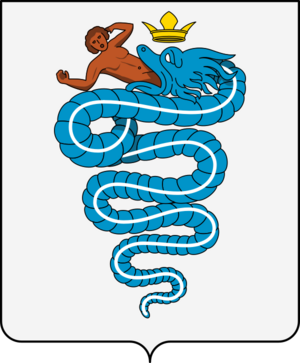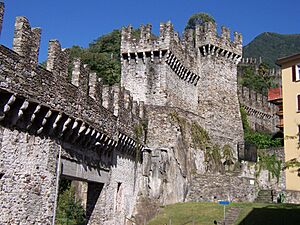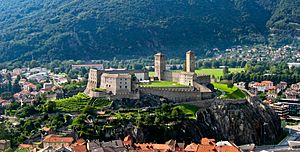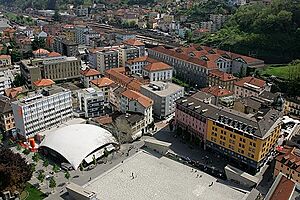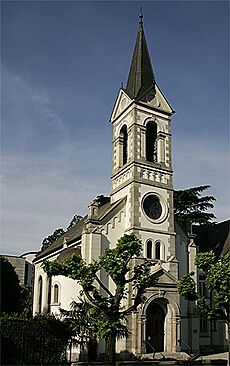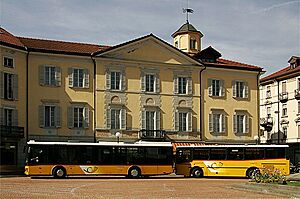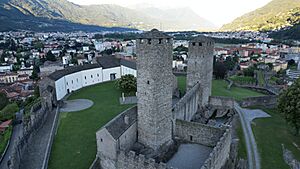Bellinzona facts for kids
Quick facts for kids
Bellinzona
|
||
|---|---|---|

View of Piazza Collegiata and Castelgrande
|
||
|
||
| Country | Switzerland | |
| Canton | Ticino | |
| District | Bellinzona | |
| Area | ||
| • Total | 19.12 km2 (7.38 sq mi) | |
| Elevation
(Stazione di Bellinzona)
|
241 m (791 ft) | |
| Highest elevation
(Poncione di Piotta)
|
2,440 m (8,010 ft) | |
| Lowest elevation | 200 m (700 ft) | |
| Population
(Dec 2020 )
|
||
| • Total | 43,360 | |
| • Density | 2,267.8/km2 (5,873.5/sq mi) | |
| Postal code |
6500 (town only)
|
|
| Localities | Artore, Carasso, Daro, Ravecchia, Camorino, Claro, Giubiasco, Gnosca, Gorduno, Gudo, Moleno, Monte Carasso, Pianezzo, Preonzo, Sant'Antonio, and Sementina | |
| Surrounded by | Arbedo-Castione, Giubiasco, Gorduno, Monte Carasso, Pianezzo, Sant'Antonio | |
Bellinzona is a historic Swiss town and the capital of the canton of Ticino in Switzerland. It's famous for its three amazing castles: Castelgrande, Montebello, and Sasso Corbaro. These castles became UNESCO World Heritage Sites in 2000, meaning they are very important places for everyone to protect.
The town is located east of the Ticino River, right at the bottom of the Swiss Alps. It stretches along the river valley, surrounded by mountains.
Contents
- Exploring Bellinzona: Name and Symbols
- Bellinzona's Past: A Look at History
- Bellinzona's Location and Landscape
- People of Bellinzona
- Bellinzona's Economy
- Religion in Bellinzona
- Learning in Bellinzona
- Getting Around: Transportation
- Fun and Culture in Bellinzona
- Sports in Bellinzona
- Important Heritage Sites
- The Three Castles: Bellinzona's Famous Fortresses
- Famous People from Bellinzona
- Images for kids
- See also
Exploring Bellinzona: Name and Symbols
The name Bellinzona first appeared in old Latin writings around the year 590. It might come from an ancient word meaning "juniper" or "juniper bushes."
Over time, the name changed a bit, but it settled on Bellinzona. Some people used to think the name came from "war zone" because of the town's history of battles.
The town's coat of arms shows a silver snake standing upright on a red background. This snake is called a "Biscione" in Italian. It's linked to the Visconti of Milan, a powerful family who ruled Bellinzona in the 1300s and 1400s. You might even see this snake on Alfa Romeo cars!
Bellinzona's Past: A Look at History
Bellinzona has always been a super important spot in the Alps. It sits at a crossroads, connecting the Po Valley in Italy to the south with high mountain passes like St. Gotthard to the north. These passes were vital for trade and travel.
Ancient Times: Romans and Early Forts
People have lived in this area since the Stone Age. But it was the Romans who built the first fort here around 100 BC. This fort was later rebuilt and made much bigger in the 300s AD. The Romans knew Bellinzona was a key place to defend northern Italy from invaders. A large castle was built, and a town called Bilitio grew up around it.
After the Roman Empire fell, different groups like the Ostrogoths, Byzantines, and Longobards took control of Bellinzona. They all used the castle to control the important mountain passes. Under the Longobards, Bellinzona had a permanent army to protect the region from other tribes.
Middle Ages: Frankish Rule and Conflicts
Around 774, the Frankish Kingdom (which later became the Carolingian Empire) took over Bellinzona.
Later, in 1002, the Holy Roman Emperor Otto III wanted to expand his power into Italy. He gave control of Bellinzona to the Bishop of Como. But conflicts continued.
During the 11th century, Bellinzona and its castle were controlled by the Hohenstaufens. Then, in 1180, Frederick I gave the town to Como. The town of Como often sided with the Pope against the Emperor. However, in 1239, Como joined the Emperor, and Bellinzona's castle was strengthened.
Later, Milan, which supported the Pope, took Bellinzona in 1242. But Bellinzona went back to Como's control in 1249. Battles continued in northern Italy. The Castelgrande was attacked many times. Around the late 1200s, the Rusca family from Como built another castle in Bellinzona, called Montebello. This was lucky for them, as they were later forced out of Como and moved to Bellinzona.
In 1340, Milan attacked Bellinzona. After a long fight, Milan took control, but the Rusca family was allowed to keep Montebello. Milan would rule Bellinzona for the next 150 years.
Growing Stronger: Bellinzona Under Milan
Under Milan's rule, Bellinzona became a busy trading hub. More and more goods passed through the St. Gotthard Pass. In the late 1300s, a long wall called the Murata was built across the Ticino valley. This wall helped Milan protect the trade route and collect taxes.
In 1402, the Duke of Milan died, causing trouble. Bellinzona was taken over by different groups. In 1419, the Swiss cantons of Uri and Obwalden took control. But Milan fought back and defeated the Swiss at the Battle of Arbedo in 1422. This stopped the Swiss from expanding further south for a while.
During this time of unrest, a tower was built outside the town. This tower would later become the third castle, Sasso Corbaro.
Battles continued, but in 1447, Francesco I Sforza took power in Milan, bringing peace. Bellinzona accepted the new Sforza rulers.
However, the peace broke in 1478 when the Swiss attacked Bellinzona again, but failed. To make up for it, the Swiss won a big victory at the Battle of Giornico. After this, Milan built the Sasso Corbaro castle and made the other two castles and the Murata wall even stronger. Many of the castles and walls you see today were built during this time in the late 1400s.
Joining Switzerland: A New Chapter
In 1499, Milan's rule over Bellinzona ended when Louis XII of France invaded Milan. He took Bellinzona and put 1000 soldiers in Castelgrande. But the people of Bellinzona revolted in January 1500 and drove out the French.
To protect themselves from France, Bellinzona joined the Swiss Confederation on April 14, 1500. It was governed by the cantons of Uri, Schwyz, and Nidwalden. After the French invaded Switzerland in 1798, Bellinzona became the capital of the new canton of Bellinzona.
Bellinzona Since 1803
In 1803, Bellinzona became part of the new, independent canton of Ticino. It was the capital from 1803 to 1814. From then until 1878, Bellinzona, Lugano, and Locarno took turns being the capital every six years. But in 1878, Bellinzona officially became the permanent capital of Ticino.
The town grew over time, adding nearby villages like Carasso, Daro, and Ravecchia in 1907.
In 1874, the first parts of the Gotthard railway opened, connecting Bellinzona to other towns. By 1882, the whole line was open, linking Bellinzona to northern Switzerland through the Gotthard Tunnel and south to Italy. This made Bellinzona an even more important transport hub.
Bellinzona's Location and Landscape
On April 2, 2017, several nearby towns like Camorino and Giubiasco joined Bellinzona, making the municipality much larger.
Bellinzona is in the valley of the Ticino River, about 240 meters (787 feet) above sea level. The town center is about 1 kilometer (0.6 miles) east of the river. The town's boundaries stretch up both sides of the valley, reaching high into the mountains.
The Ticino River, which flows south, turns west at Bellinzona. It then flows through a wide plain before reaching Lake Maggiore and eventually the Po Valley in Italy.
To the north, several valleys lead into the high Alps, offering access to northern Switzerland through passes like the Passo del San Gottardo. To the south, the Monte Ceneri Pass crosses the mountains, leading to Lake Lugano and another route to Italy.
Bellinzona's land is about 22% farmland and 62.5% covered by forests. A good portion, 23.8%, is built up with buildings and roads.
People of Bellinzona
Bellinzona has a population of about 55,906 people. In 2008, nearly 30% of the people living here were from other countries.
Most people in Bellinzona speak Italian (about 87.4%). German is the second most common language, and Serbo-Croatian is third.
The population includes a mix of ages, from young children to older adults. The town has many families, with an average of 2.2 people per household.
Bellinzona's Economy
Bellinzona's main industry is mechanical engineering. A local bank, Società Bancaria Ticinese, is based here. The biggest employer in the town is the Swiss Federal Railways.
Many people work in Bellinzona. In 2005, there were 33 people working in farming, over 1,600 in manufacturing, and more than 11,600 in service jobs (like shops, offices, and hotels).
Bellinzona is a place where many people come to work. About 45% of the workers who come into Bellinzona are from outside Switzerland. Most people (about 50%) use a private car to get to work, while about 8.8% use public transportation.
In 2009, Bellinzona had 9 hotels with a total of 145 rooms for visitors.
Religion in Bellinzona
According to a 2000 survey, most people in Bellinzona (about 74%) are Roman Catholic. About 4% belong to the Swiss Reformed Church. Many other people belong to different churches or did not state their religion.
Learning in Bellinzona
Bellinzona has a good education system. About 60.5% of adults (aged 25–64) have finished high school or gone on to higher education like university.
In 2009, there were 2,662 students in Bellinzona. The education system includes up to three years of non-mandatory kindergarten. There are also primary schools, middle schools, and programs to prepare students for higher education or specific jobs.
Bellinzona is home to two libraries: the Biblioteca Cantonale Bellinzona and the Biblioteca comunale. In 2008, these libraries had over 138,000 books and other media.
Getting Around: Transportation
The Bellinzona railway station is a very important stop on the Gotthard railway line. Major trains stop here, going north to Zürich and south to Milan, Italy. There are also regional trains that connect Bellinzona to nearby towns like Locarno.
PostBus Switzerland, also known as the AutoPostale, runs city buses in Bellinzona and longer routes to other towns. All these buses stop at the railway station.
The A2 and A13 motorways (major highways) also meet in Bellinzona, making it a key place for road travel. The A2 goes north to Germany and south to Italy. The A13 goes northeast to Austria.
Fun and Culture in Bellinzona
Bellinzona is famous for its carnival called Rabadan, which has been celebrated for over 150 years! It's a big, fun event with parades and festivities.
Bellinzona in Art
-
Bellinzona by J. M. W. Turner - 1830.
-
Bellinzona by J. M. W. Turner - 1841.
Sports in Bellinzona
Bellinzona has several sports teams:
- The football (soccer) club AC Bellinzona plays in the Swiss Challenge League.
- The hockey team, GDT Bellinzona, plays in the Swiss 1. Liga.
- The female basketball team, Pallacanestro Bellinzona, plays in the National League A.
- The floorball team, Ticino Unihockey, plays in the National League B.
The local athletics group, GAB Bellinzona, hosts an annual event called "Galà dei Castelli" (Castles' Gala). Many famous athletes and top Swiss athletes compete there.
Important Heritage Sites
Bellinzona is home to many important historical buildings and areas. Twelve of them are listed as Swiss heritage sites of national significance. The most famous are the Three Castles of Bellinzona, which are a UNESCO World Heritage Site.
The entire old town of Bellinzona is also a protected heritage site. Other important buildings include three churches: S. Maria delle Grazie, Collegiata dei Ss. Pietro e Stefano, and S. Biagio a Ravecchia. The Cantonal Archives, a public bath, a secondary school, and the Teatro sociale (a theater) are also on the list.
The Three Castles: Bellinzona's Famous Fortresses
The Three Castles of Bellinzona, along with their defensive walls and ramparts, became a UNESCO World Heritage Site in 2000. They are: Castelgrande, Montebello, and Sasso Corbaro. These castles and walls protected the old town and controlled important trade routes.
Castelgrande: The Oldest Castle
The site of Castelgrande has been a fortified place since at least 100 BC. For a long time, it was the only castle in Bellinzona. Over its history, it has been called the stronghold, the Old Castle, Uri Castle, and Saint Michael's Castle.
Castelgrande sits on a rocky peak with very steep sides. The castle's shape follows the natural contours of the hill. While the original Roman fort isn't visible, its foundations were used for the later medieval castle. Most of what you see today was built between 1250 and 1500, with many updates in the last two centuries.
The area inside the castle walls is now mostly flat and open. Long ago, it was filled with buildings, but the Dukes of Milan removed most of them to create open spaces. These spaces were used to house soldiers stationed in Bellinzona. The outer walls were also made taller and stronger, and towers were added.
You can reach Castelgrande by taking an elevator from the bottom of the rock or by walking up steep, narrow streets from the town center.
Montebello: The Middle Castle
Montebello Castle (also known as the Small, New, or Middle Castle) is located east of the town center. It was built before 1313 for the Rusca family. They used it after the Visconti family took over Castelgrande. By the end of the 1300s, Montebello was also controlled by the Visconti. The castle was updated and made bigger between 1462 and 1490, reaching its current look.
Inside Montebello Castle, there's a small chapel dedicated to Saint Michael, built around 1600. It's one of the few buildings added to the castles when the Swiss cantons ruled Bellinzona.
Montebello Castle is also home to the Archaeological and Civic Museum. This museum opened in 1974 and is located in the castle's tower and old living areas. It has two parts: history and archaeology. The history section shows things like old stone carvings and a rare 13th-century baptismal font, plus drawings and weapons. The archaeology section displays items from 1400 to 1500 BC, including pottery, glass, and jewelry found in the canton. The museum is open from March to November.
Sasso Corbaro: The Highest Castle
Sasso Corbaro (also called Unterwalden Castle or Saint Barbara's Castle) is about 600 meters (about 2,000 feet) southwest of town on a rocky hill. Unlike the other two castles, Sasso Corbaro is not connected to the town walls. The first part of the castle, the north-eastern tower, was built in 1478 to fill a gap in the town's defenses. The rest of the walls and the south-west tower were added later. The castle was hit by lightning many times and was falling apart by 1900.
Today, Sasso Corbaro Castle has the Sala Emma Poglia, a beautiful "wooden room" built for the Emma family in the 1600s. This room, made entirely of walnut wood, was moved to the castle in 1989. It even has a special stove with the Emma family crest. The museum also hosts temporary exhibits. It is open from March to November.
Famous People from Bellinzona
- Louis Wyrsch (1793–1858), a politician and military leader.
- Carlo Salvioni (1858–1920), a linguist who studied Romance languages.
- Laura Solari (1913–1984), an Italian film actress.
- Ernst Brugger (1914–1998), a politician who was part of the Swiss Federal Council.
- Giorgio Orelli (1921–2013), a Swiss poet, writer, and translator.
- Kubilay Türkyilmaz (born 1967), a famous former footballer for Switzerland.
- Massimo Busacca (born 1969), a former football referee for FIFA.
- Nicole Bullo (born 1987), an ice hockey defender who plays for the Swiss national team and competed in the Olympics.
Images for kids
See also
 In Spanish: Bellinzona para niños
In Spanish: Bellinzona para niños






